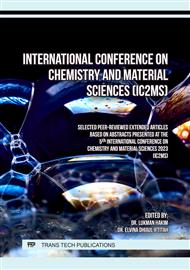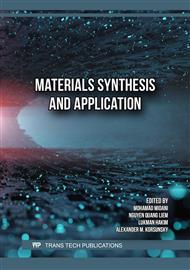[1]
A. Pribadi, Nickel Downstreaming Creates Added Value and Economic Strength, Indonesian Ministry of Energy and Mineral Resources. (2020), https://www.esdm.go.id/id/media-center/arsip-berita/hilirisasi-nikel-ciptakan-nilai-tambah-dan-daya-tahan-ekonomi, accessed: 12 May 2023.
Google Scholar
[2]
I. M. I. M. Brunner & S. M. Brunner, Pemilihan baterai kendaraan listrik dengan metoda weighted objective, J. Serambi Eng. 6 (2021) 1563 – 1572.
DOI: 10.32672/jse.v6i1.2644
Google Scholar
[3]
Wang, Minxi and Ma, Yu and Li, Xin, Analysis of the Characteristics and Stability of the Global Complex Nickel Ore Trade Network. Available at SSRN: https://ssrn.com/abstract=4088230 or
DOI: 10.2139/ssrn.4088230
Google Scholar
[4]
S. Soni, P. K. Bajpai, & C. Arora, A review on metal-organic framework: Synthesis, properties and application", Charact. Appl. Nanomater. 3 (2020). 87–106.
Google Scholar
[5]
M. Safaei, M. M. Foroughi, N. Ebrahimpoor, S. Jahani, A. Omidi, & M. Khatami, A review on metal-organic frameworks: Synthesis and applications, TrAC. 118 (2019) 401-425.
DOI: 10.1016/j.trac.2019.06.007
Google Scholar
[6]
W. Lu, Z. Wei, Z-Y. Gu, T-F. Liu. et al. Tuning the structure and function of metal–organic frameworks via linker design, Chem. Soc. 43 (2014) 5561–5593.
DOI: 10.1039/c4cs00003j
Google Scholar
[7]
S. Tarighi, A. Abbasi, S. Geranmayeh, A. Badiei, Synthesis of a new interpenetrated mixed ligand Ni(II) metal–organic framework: structural, thermal and fluorescence studies and its thermal decomposition to NiO nanoparticles, J. Inorg. Organomet. Polymers Mater. 23 (2013) 808–815.
DOI: 10.1007/s10904-013-9845-6
Google Scholar
[8]
H. Li, M. Eddaoudi, T. L. Groy, O. M. Yaghi, Establishing microporosity in open metal−organic frameworks: Gas sorption isotherms for Zn(BDC) (BDC = 1,4 benzenedicarboxylate), J. Am. Chem. Soc. 120 (1998) 8571–8572.
DOI: 10.1021/ja981669x
Google Scholar
[9]
M. Eddaoudi, H. Li, T. Reineke, M. Fehr, D. Kelley, T. L. Groy, & O. M. Yaghi, Design and synthesis of metal–carboxylate frameworks with permanent microporosity, Topics in Catalysis. 9 (1999) 105–111.
DOI: 10.1023/a:1019110622091
Google Scholar
[10]
H. Li, M. Eddaoudi, M. O'Keeffe, & O. M. Yaghi, Design and synthesis of an exceptionally stable and highly porous metal–organic framework, Nature. 402 (1999) 276–279.
DOI: 10.1038/46248
Google Scholar
[11]
S. Dhaka, R. Kumar, A. Deep, M. B. Kurade, S. W. Ji, & B. H. Jeon, Metal–organic frameworks (MOFs) for the removal of emerging contaminants from aquatic environments. Coord. Chem. Rev. 380 (2019) 330–352.
DOI: 10.1016/j.ccr.2018.10.003
Google Scholar
[12]
H.B.T. Jeazet, C. Staudt, & C. Janiak, Metal–organic frameworks in mixed-matrix membranes for gas separation, Dalton Trans. 41 (2012) 14003-14027.
DOI: 10.1039/c2dt31550e
Google Scholar
[13]
A. Huang, Y. Che, Q. Liu, N. Wang, J. Jiang, J. Caro, Synthesis of highly hydrophobic and permselective metal–organic framework Zn(BDC)(TED)0.5 membranes for H2/CO2 separation, J. Membrane Sci. 454 (2014) 126–132.
DOI: 10.1016/j.memsci.2013.12.018
Google Scholar
[14]
L. Peng, S. Wu, X. Yang, J. Hu, Q. Huo, J. Guan, Application of metal organic frameworks M(bdc)(ted)0.5 (M = Co, Zn, Ni, Cu) in the oxidation of benzyl alcohol, RSC Adv. 6 (2016) 72433–72438.
DOI: 10.1039/c6ra12799a
Google Scholar
[15]
G. Gumilar, Y. V. Kaneti, J. Henzie, S. Chatterjee, J. Na, B.Yuliarto, N. Nugraha, A. Patah, A. Bhaumik, Y. Yamauchi, General synthesis of hierarchical sheet/plate-like M-BDC (M = Cu, Mn, Ni, and Zr) metal–organic frameworks for electrochemical non-enzymatic glucose sensing, Chem. Sci. 11 (2020) 3644–3655.
DOI: 10.1039/c9sc05636j
Google Scholar
[16]
B. T. Niu, W. N. Xia, Z. Q. Lai, H. X. Guo, Z. X. Chen, Solvent-controlled morphology of Ni-BTC and Ni-BDC metal-organic frameworks for supercapacitors, Chinese J. Inorg. Chem. 38 (2022) 1643 – 1654.
Google Scholar
[17]
C. P. Raptopoulou, Metal-Organic Frameworks: Synthetic Methods and Potential Applications, Materials, 14 (2021) 310.
DOI: 10.3390/ma14020310
Google Scholar
[18]
S. Pullen, G. H. Clever, Mixed-ligand metal–organic frameworks and heteroleptic coordination cages as multifunctional scaffolds—A Comparison, Acc. Chem. Res. 51 (2018) 3052–3064.
DOI: 10.1021/acs.accounts.8b00415
Google Scholar
[19]
S.H. Feng, G. Li, Chapter: Hydrothermal and solvothermal syntheses, in Modern Inorganic Synthetic Chemistry, 2nd ed. Elsevier, (2017) 73–104.
DOI: 10.1016/b978-0-444-63591-4.00004-5
Google Scholar
[20]
D.-C. Hou, G.-Y. Jiang, H.-R. Fu, Z. Zhao, and J. Zhang. A microporous nickel–organic framework with an unusual 10-connected BCT net and high capacity for CO2, H2 and hydrocarbons. Cryst. Eng. Comm., 15 (2013) 9499–9503.
DOI: 10.1039/c3ce40548f
Google Scholar



